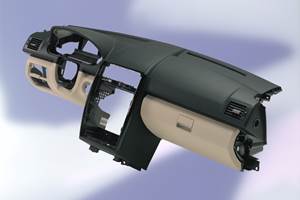'Soft-on-Soft' Is Newest Option In Soft-Touch Molding
It's hailed as a breakthrough for soft-touch injection molding: Collaborative efforts by three companies have resulted in the commercialization of an SEBS-based TPE vehicle handle in which a very soft (28 Shore A) surface layer is coinjected onto a substrate of a firmer—but still soft and rubbery—60 Shore A compound.
It's hailed as a breakthrough for soft-touch injection molding: Collaborative efforts by three companies have resulted in the commercialization of an SEBS-based TPE vehicle handle in which a very soft (28 Shore A) surface layer is coinjected onto a substrate of a firmer—but still soft and rubbery—60 Shore A compound. This "soft-on-soft" molding opens the door to new design options that were thwarted by previous limitations in materials and molding techniques.
The partners say that to their knowledge, all of the rapidly multiplying "soft-touch" applications in handles, grips, buttons, and knobs have been "soft-on-hard" structures. In these applications, a 60 Shore A thermoplastic elastomer is typically coinjected onto a rigid polypropylene or ABS substrate using twin-shot molding. The arrival of soft-on-soft capability means that designers of soft-touch parts can now differentiate products further by tapping a broader range of softness.
The molder of the breakthrough soft-on-soft TPE handle is Slatebond in Corsham, Wiltshire, U.K., which used a pair of Evoprene G compounds from U.S.-based AlphaGary Corp. The compounds were based on Kraton G SEBS resins supplied by Kraton Polymers. A new-generation grade with enhanced flow properties was used for the super-soft surface layer. Slatebond says it can make parts as soft as 15 Shore A hardness.
According to Slatebond's commercial manager, Adrian Mumford, its variable-softness handle puts end-users in the "best of all worlds." He says the surface softness prevents hand blisters, while the firmer substrate resists abuse and chemicals. Slatebond's design replaces an existing vehicle handle of a 60 Shore A SEBS that was slipped onto a rigid handle.
Soft-on-soft challenge
Previous barriers to soft-on-soft molding included a tendency for the pressures of injection molding to deform soft substrates. Strong adhesion between different soft TPE materials was also hard to achieve. Derek Fraser, AlphaGary's global business manager, compares the problem to attempting to stick a stamp onto an envelope that is lying on a soft pillow. The challenge is especially difficult when it involves a thin-wall part. Fraser says the handle made by Slatebond consists of a 1 mm-thick, softer surface layer overmolded on a 3-mm substrate.
Fraser says one key to the solution was adapting the hot-runner and gating design in the tool previously used to make the single-hardness, 60 Shore A handle. Equally important was the special high-flow SEBS resin developed by Kraton for the 28 Shore A compound. That resin's easier flow helped prevent voids at the soft-soft interface. It also minimized knit line formation and ensured good adhesion of the soft layers, according to Fraser.
Exploring new territory
The partners are exploring potential for soft-soft design in additional applications. They argue that if the concept works for a vehicle handle, it can also be used for numerous other handles and grips for anything from knives to crates to wheelbarrows. Slatebond is already working on other applications.
Kraton Polymers anticipates that soft-on-soft molding will catch on rapidly once initial applications prove themselves in the market. Rolf Schrauwen, Kraton's compounding account manager, says target markets include appliances, packaging, sports gear, and auto interior parts. He sees soft-soft designs replacing some current soft-hard applications and fostering entirely new uses. Schrauwen compares the status of the soft-soft concept today to that of hard-soft products a decade ago.
Related Content
Hybrid EPDM-TPE Adhesion Compounds for Automotive Industry
Kraiburg’s new compounds targeted to auto sealing and exterior sector applications and toolmakers.
Read MorePIR/PCR Recycled Content and Biobased TPEs for Broad Range of Applications
NPE2024: Kraiburg TPE launching PCR/PIR content polyolefin-based TPEs and its expanded line of Thermolast R biobased TPEs.
Read MoreTracing the History of Polymeric Materials -- Part 29: Polyurethane
This material family has unparalleled versatility, not only in terms of the forms the material can take, but in the different ways in which it can be processed.
Read MoreTPEs with 60% Postconsumer Recycled Content
Teknor says its new Monprene R6 CP-10100 series reduce carbon footprint by up to 36% while maintaining translucency for vibrant colors
Read MoreRead Next
Making the Circular Economy a Reality
Driven by brand owner demands and new worldwide legislation, the entire supply chain is working toward the shift to circularity, with some evidence the circular economy has already begun.
Read MorePeople 4.0 – How to Get Buy-In from Your Staff for Industry 4.0 Systems
Implementing a production monitoring system as the foundation of a ‘smart factory’ is about integrating people with new technology as much as it is about integrating machines and computers. Here are tips from a company that has gone through the process.
Read More



















